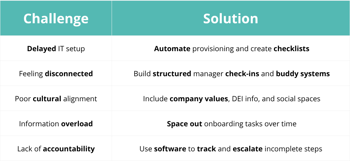
What is remote employee onboarding?
Remote employee onboarding is the process of integrating new hires into an organisation when they are working from home or a location other than a central office. It includes everything from paperwork and system access to cultural orientation and manager check-ins.
Remote onboarding should mirror the goals of in-person onboarding: make the employee feel welcomed, prepared, and confident in their role. It’s particularly important to get onboarding of remote employees to be an overwhelmingly positive experience. With large workforces, it can be challenging to arrange employees to visit an office to integrate with the culture. Therefore, a structured, step-by-step process that can scale across your large organisation can have a lasting impact.
How to onboard a new employee remotely – step-by-step
Here's a scalable, repeatable process tailored for remote hires:
Start with preboarding
- Send welcome emails and company videos.
- Assign onboarding buddies.
- Share a "Week One Overview" and any pre-start tasks.
Deliver IT and access before day one
- Ship laptop, headset, phone (if needed).
- Set up logins, email, VPN, and software access.
Create a structured onboarding plan
- Use onboarding software to automate task workflows.
- Include role-specific milestones for the first 30, 60, 90 days.
Host virtual welcome sessions
- Introduce them to the team and leadership.
- Schedule 1:1s with their manager and peers.
Provide training and resources
- Offer a digital handbook, LMS access, and how-to guides.
- Include health & safety, compliance, and product/service training.
Track progress and get feedback
- Use surveys or pulse checks at regular intervals.
- Schedule follow-ups to monitor performance and wellbeing.
Our employee onboarding checklist template helps ensure you have everything in place for your new employee’s first day and beyond.
The importance of early onboarding for engagement
Expert Insights: Zoe Wilson, Founder and Director of ReThink HR, discusses the importance of staring onboarding before the first day to engage your new starters, build relationships, and instill company culture.
To hear the full discussion on onboarding your new starters effectively and how AI can help you improve your onboarding processes, watch Episode 4 of our Do The Best Work of Your Life series.
What are best practices for onboarding remote employees at scale?
For medium and large organisations, onboarding remote employees comes with extra layers of complexity. Here are some essential best practices:
1. Standardise where possible
Create centralised onboarding workflows across departments using HR or HCM software. Automate task assignments to HR, IT, and managers to avoid delays.
2. Personalise the experience
Use onboarding portals that adjust content based on the role, department, and location. Include videos from leaders or tailored messages from the team. Personalising can really elevate your onboarding experience; Enboarders 2024 State of Employee Onboarding Report shows that ‘while three-quarters of employees are generally satisfied with their onboarding, they lack deeply impactful experiences. Only 53% reporting ever having had a truly amazing or satisfying onboarding journey.’
3. Build connections early
Start engagement before day one with buddy systems, informal chats, and introductions to internal networks like Slack groups or DEI communities. Eighty percent of the most satisfied group in Enboarders 2024 State of Employee Onboarding Report noted an early start and its benefits, illustrating the importance of proactive engagement during preboarding.
4. Support asynchronous learning
Offer content that can be consumed at any time, especially important for global or hybrid teams. Include a mix of formats: video, interactive, text-based.
5. Track completion and measure engagement
Use digital dashboards to monitor who has completed onboarding, and run surveys to understand sentiment.
Your remote employee onboarding processes can be monitored by HR departments and managers through one simple yet powerful platform. Our onboarding software includes dedicated tools to streamline internal processes, as well as boosting new hire experience.
5 Tips and onboarding ideas for remote employees
- Create a "Get to Know You" session with icebreaker games.
- Deliver a welcome package to their home.
- Assign stretch tasks or team mini-projects to build confidence.
- Run a virtual Q&A with leadership in week one.
- Encourage use of internal social tools to build culture.
What tools or software support remote onboarding?
Remote onboarding software can simplify and standardise onboarding at scale. Look for platforms that offer:
- Workflow automation for onboarding tasks
- Document sharing and e-signatures
- New hire portals with training modules
- Survey tools for engagement tracking
Systems that allow you to integrate surveys directly into them can help you track sentiment and engagement. For example, you can take a survey like our Employee Engagement Survey, designed to help you measure how connected, satisfied, and supported your employees feel, and build it directly in a HR software system like PeopleXD Evo. With end-to-end AI support enabled, you can then surface results from surveys instantly and drive actionable insights and strategies.
Selecting the right onboarding platform is crucial for scaling your remote hiring processes effectively. If you're evaluating HR tech solutions or looking to upgrade your current systems, our vendor evaluation toolkit provides expert guidance on how to assess vendors, avoid common pitfalls, and choose technology that truly supports your long-term goals.
Common challenges in onboarding remote workers (and how to solve them)
Remote onboarding presents unique hurdles that could impact your new hire's early experience and long-term success. Understanding these challenges and implementing targeted solutions helps create a more engaging and effective onboarding journey for distributed team members.
Delayed IT setup
When new starters are working remotely, delayed equipment delivery or configuration issues can leave them unable to begin their role effectively. This challenge often stems from manual processes and unclear ownership of IT provisioning tasks across different departments, particularly in larger organisations managing multiple new hires simultaneously.
The solution: Implement automated provisioning workflows that trigger as soon as an offer is accepted. Create comprehensive IT setup checklists that clearly define responsibilities between HR, IT, and line managers. For organisations onboarding multiple remote employees, standardised processes could include partnerships with technology suppliers who can deliver and configure equipment directly to employees' homes, with pre-installed software and security protocols already in place. This scalable approach ensures all new hires can be productive from day one, rather than spending their first week troubleshooting technical issues.
Feeling disconnected
Remote workers can struggle to develop meaningful relationships with colleagues and feel isolated from company culture. Without casual office interactions and visual cues, new hires may find it challenging to understand team dynamics and build the connections that drive engagement. This challenge can be amplified in large organisations where new remote employees might otherwise rely on organic networking opportunities.
The solution: Establish structured manager check-ins during the first 90 days, moving from daily touchpoints in week one to weekly sessions thereafter. Implement a formal buddy system with standardised guidelines that can be replicated across departments, pairing new hires with experienced team members who can provide informal guidance and answer cultural questions. For larger organisations managing numerous remote onboardings, these buddy relationships could be facilitated through dedicated onboarding platforms that match employees based on role, location, or interests. Encourage video calls over phone conversations to foster stronger personal connections, and create dedicated time for non-work conversations during virtual meetings.
Poor cultural alignment
Company values and cultural nuances can be harder to communicate and absorb in a remote environment. Without observing day-to-day behaviours and informal interactions, new starters may struggle to understand what drives decision-making and how the organisation really operates. This challenge could be particularly pronounced in large organisations with diverse teams and complex hierarchies.
The solution: Develop comprehensive cultural onboarding content that goes beyond written policies and can be consistently delivered to remote employees across all departments. Include video messages from leadership explaining company values with real examples, and create virtual spaces where new hires can interact with colleagues from different departments. Large organisations could benefit from hosting regular virtual coffee sessions or online social events during the onboarding period, creating scalable opportunities for connection. Incorporate diversity, equity, and inclusion information that demonstrates your organisation's commitment to creating an inclusive remote culture.
Information overload
The temptation to frontload all necessary information in the first few days can overwhelm remote workers who are already navigating new technology and processes without in-person support. This approach often leads to poor retention of important information and increased anxiety, particularly when organisations need to onboard multiple remote employees with consistent quality.
The solution: Space onboarding tasks across several weeks rather than cramming everything into the first few days. Create a progressive learning path that introduces role-specific information gradually, allowing time for new hires to process and apply what they've learned. For larger organisations, standardised microlearning modules that can be completed in 10-15 minute sessions could provide consistency whilst being easily scalable across departments. Provide easily accessible resources that employees can reference when needed, ensuring all remote workers receive the same quality of information regardless of their location or start date.
Lack of accountability
Without clear tracking mechanisms, it can become difficult to monitor onboarding progress and identify when new hires need additional support. This challenge is amplified in remote settings where managers have less visibility into day-to-day activities, and can be particularly complex for organisations managing numerous remote onboardings simultaneously.
The solution: Leverage onboarding software that automatically tracks completion of tasks and sends escalation alerts when deadlines are missed. Create clear accountability frameworks that define who is responsible for different aspects of the onboarding journey, from IT setup to cultural integration. For large organisations, implementing standardised progress review templates could ensure consistent support across all departments and locations. These regular progress reviews allow managers to identify and address gaps before they become significant issues, whilst maintaining quality standards regardless of team size or geographical distribution.
Creating successful remote onboarding experiences
Remote onboarding success depends on proactive planning, clear communication, and the right technology to support distributed teams at scale. By addressing these common challenges systematically, large organisations can create engaging onboarding experiences that help remote workers feel connected, productive, and valued from their very first day. The investment in structured, replicable remote onboarding processes pays dividends through improved retention rates, faster time-to-productivity, and stronger employee engagement across your distributed workforce, whilst ensuring consistent quality regardless of team size or location.

Final thoughts on onboarding remote employees
Onboarding remote employees doesn’t have to be complex or disconnected. With the right tools and a structured, human-first approach, you can turn every remote hire into a confident, engaged, and loyal team member.
If you’re looking to improve your onboarding process, explore our HR software and onboarding solutions designed to support hybrid and remote teams.
An onboarding survey can be also be helpful tool in allowing companies the opportunity to gather valuable insights from new starters.

 AU & NZ
AU & NZ
 SG
SG
 MY
MY
 US
US
 IE
IE
